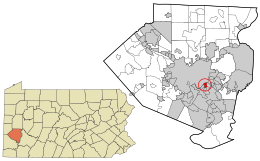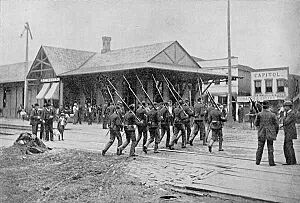Homestead, Pennsylvania facts for kids
Quick facts for kids
Homestead, Pennsylvania
|
|
|---|---|
|
Borough
|
|

The Bost Building, built in 1892, was AA union headquarters during the Homestead Strike that year, and today is a National Historic Landmark and museum of the Rivers of Steel National Heritage Area
|
|

Location in Allegheny County and the U.S. state of Pennsylvania
|
|
| Country | United States |
| State | Pennsylvania |
| County | Allegheny |
| Area | |
| • Total | 0.64 sq mi (1.66 km2) |
| • Land | 0.58 sq mi (1.49 km2) |
| • Water | 0.07 sq mi (0.17 km2) |
| Population
(2020)
|
|
| • Total | 2,884 |
| • Density | 5,006.94/sq mi (1,932.88/km2) |
| Time zone | UTC-5 (EST) |
| • Summer (DST) | UTC-4 (EDT) |
| ZIP Code |
15120
|
| Area code(s) | 412 |
| FIPS code | 42-35424 |
Homestead is a town, also called a borough, in Allegheny County, Pennsylvania, United States. It is located along the Monongahela River, about 7 miles (11 km) southeast of downtown Pittsburgh. Homestead is well-known for the Homestead strike of 1892. This was a very important event in the history of how workers and companies dealt with each other in the United States. In 2020, about 2,884 people lived in Homestead. It is part of the larger Pittsburgh metropolitan area.
Contents
History of Homestead
The first European settlers arrived in the Homestead area in the 1770s. This area is on the south bank of the Monongahela River. About 100 years later, local banks and landowners bought much of the farmland. They divided it into lots and sold them to create the town of Homestead. The town officially became a borough in 1880.
The building of a railroad, a glass factory, and an iron mill in 1881 led to fast growth. This brought a time of great success for the town. In 1883, Andrew Carnegie bought the Homestead Steel Works. He added it to his large business empire of steel and coke production. Carnegie had also recently gained control of Henry Clay Frick's coke factories. This set the stage for a major conflict between workers and management in Homestead.
The Homestead Strike of 1892
Homestead became famous around the world in July 1892 because of a violent fight. This fight happened between steelworkers who were locked out of their jobs and hired guards. It is known as the Homestead Strike. In the spring of 1892, Henry Clay Frick, who managed the Homestead Steel Works for Andrew Carnegie, announced that skilled workers would get lower wages. The workers' union, the Amalgamated Association of Iron and Steel Workers, refused to sign a new contract. Carnegie's management then locked the workers out. They said the company would no longer recognize the union at the steel works.
To end the strike and protect the mill from angry workers, Henry Clay Frick hired hundreds of armed guards. These guards were from the Pinkerton National Detective Agency. When boats carrying the Pinkerton guards arrived at the mill on July 6, workers and townspeople met them at the riverbanks. It's not clear who fired the first shot, but a day-long armed battle followed. This battle resulted in eleven deaths and many injuries.
Eventually, the governor of Pennsylvania called out the National Guard. They came to bring order back to the town and take control of the mill. Frick successfully broke the union in Homestead. He also weakened unions in most of Carnegie's other steel mills across the country. The "Battle of Homestead" was a big setback for unionization in the steel industry. However, it also helped set the stage for the future steel strike of 1919, where Homestead played another important role.
Growth and Decline of Industry
Around 1900, Homestead had a population of 12,554 people. About 7,000 of them worked in the steel plants. Due to many people moving from Eastern and Southern Europe, the population grew quickly. By 1910, it reached 18,713, and then 20,452 in 1920. In the early 1900s, Homestead was studied as part of the Pittsburgh Survey. This study looked at how people lived in a mill town.
In 1940, 19,041 people lived in Homestead. In the early 1940s, half the population had to move. This happened because the United States government expanded the steel mills. They needed more space to make armor plating for ships and tanks for World War II. After the war, the steel-making industry in the United States began to decline.
By 1980, it was hard to find work at the Homestead Works. The mill was not producing much steel anymore. In 1986, the mill finally closed down. The Homestead Works was torn down in the early 1990s. In 1999, a large shopping mall called The Waterfront was built in its place. Because of the loss of mill jobs, the number of people living in Homestead decreased. By the 2010 census, the town's population was 3,165. However, the town started to recover financially in 2002. This was due to the new shopping area bringing in more tax money.
Geography
Homestead is located at 40°24′18″N 79°54′28″W / 40.40500°N 79.90778°W. The U.S. Census Bureau says the borough has a total area of about 0.6 square miles (1.6 km²). Most of this area is land, and a small part is water.
Surrounding Areas
Homestead shares land borders with two other towns: Munhall to the east and south, and West Homestead to the west. Across the Monongahela River to the north, Homestead is next to the Pittsburgh neighborhoods of Squirrel Hill South and Swisshelm Park. The Homestead Grays Bridge connects Homestead directly to Squirrel Hill South.
Population Changes
| Historical population | |||
|---|---|---|---|
| Census | Pop. | %± | |
| 1880 | 592 | — | |
| 1890 | 7,911 | 1,236.3% | |
| 1900 | 12,554 | 58.7% | |
| 1910 | 18,713 | 49.1% | |
| 1920 | 20,452 | 9.3% | |
| 1930 | 20,141 | −1.5% | |
| 1940 | 19,041 | −5.5% | |
| 1950 | 10,046 | −47.2% | |
| 1960 | 7,502 | −25.3% | |
| 1970 | 6,309 | −15.9% | |
| 1980 | 5,092 | −19.3% | |
| 1990 | 4,179 | −17.9% | |
| 2000 | 3,569 | −14.6% | |
| 2010 | 3,165 | −11.3% | |
| 2020 | 2,884 | −8.9% | |
| Sources: | |||
Homestead's population grew very quickly in the late 1800s and early 1900s. In 1880, only 592 people lived there. By 1920, the population had jumped to over 20,000! This growth was mainly because of the steel mills and people moving there for jobs.
After the steel mills closed, the population started to decrease. In 1950, it was around 10,000, and by 2020, it was 2,884. This shows how much the town changed after the steel industry left.
Arts and Culture
Many parts of Homestead and nearby communities are listed on the National Register of Historic Places. This area is known as the Homestead Historic District. It includes the place where the Homestead Strike of 1892 happened. This was when the Carnegie Steel Company, led by Henry Clay Frick, broke the workers' union.
A notable building is the Bost Building. This restored brick building was the headquarters for the striking workers during the 1892 strike. The Bost Building was named a National Landmark in 1999. Today, it has a museum about the Rivers of Steel National Heritage Area.
The Carnegie Library of Homestead opened in 1898. It was one of the first libraries built by Andrew Carnegie in the U.S. It is the third oldest Carnegie library that is still used in its original building in the U.S.
The historic St Nicholas Carpatho-Rusyn church was built in 1937. It serves the local Rusyn community. Its unique domes were built using steel from the local mills.
In 2000, a large outdoor shopping mall called The Waterfront opened. It was built on the former site of the Homestead Steel Works. Most of the old steel mill buildings were torn down to build the mall. However, some of the brick smokestacks from the mill still stand. Also, near the river, an old mill building called the Pump House was restored by the developers.
The Great Allegheny Passage is a shared-use path that runs through Homestead, next to the river. This path connects Pittsburgh to Washington, D.C..
Transportation
An important state road, Pennsylvania Route 837, goes through Homestead. Interstate 376 is also just a few miles away. For public transportation, the Port Authority of Allegheny County has several bus routes in Homestead. These buses go to downtown Pittsburgh and to McKeesport.
Homestead is served by three railroad companies: the Norfolk Southern, CSX Transportation, and the Union Railroad. All three used to have big operations when the Homestead steel mill was open. Now that the mill is closed, only one company, WHEMCO, uses the railroad. The Union Railroad used to have a large yard to serve the Homestead Works. This area is now Waterfront Drive.
Notable People
Many interesting people have come from Homestead, Pennsylvania, including:
- Charlie Batch, a professional NFL player
- Betty Davis, a singer, songwriter, and model
- Jeff Goldblum, a famous actor
- Orrin Hatch, a former President pro tempore of the United States Senate
- Curt Leskanic, a MLB player
- Frank McHugh, an actor
- Cumberland Posey, a member of both the Baseball and Basketball Halls of Fame
- Maxine Sullivan, a jazz singer
- Tamara Tunie, an actress
Images for kids
-
Carnegie Library of Homestead, built from 1896 to 1898, located in the Homestead Historic District in Munhall
-
Gantry crane at the site of Homestead Steel Works
See also
 In Spanish: Homestead (Pensilvania) para niños
In Spanish: Homestead (Pensilvania) para niños







